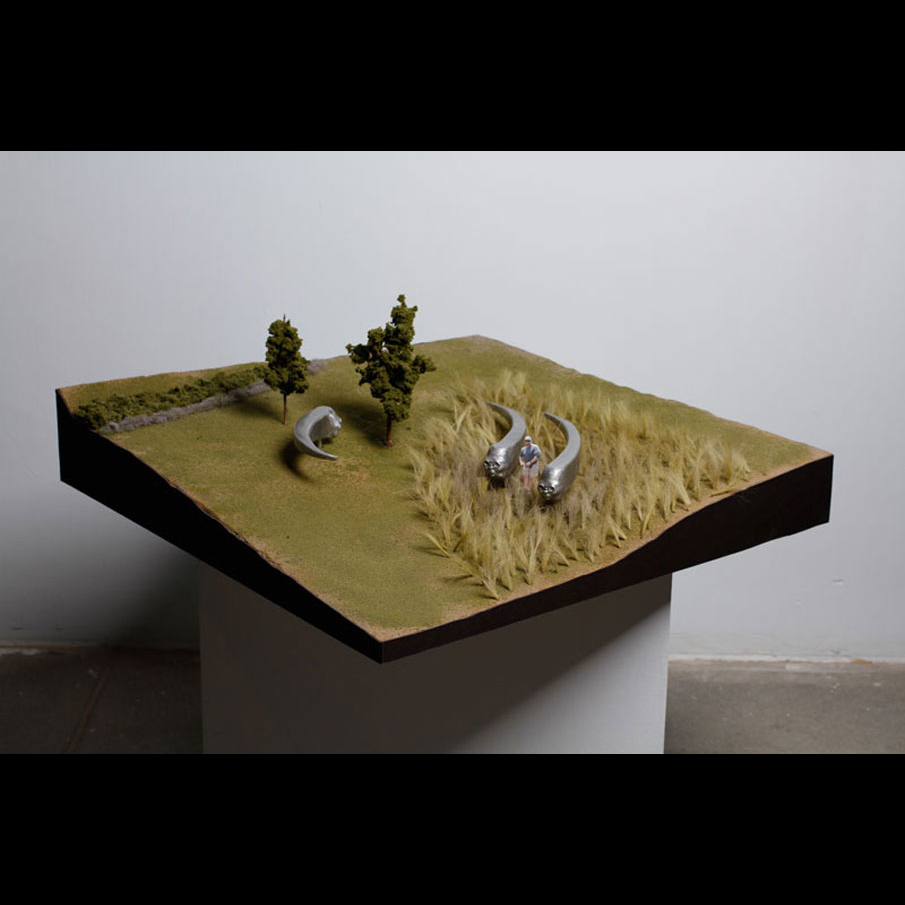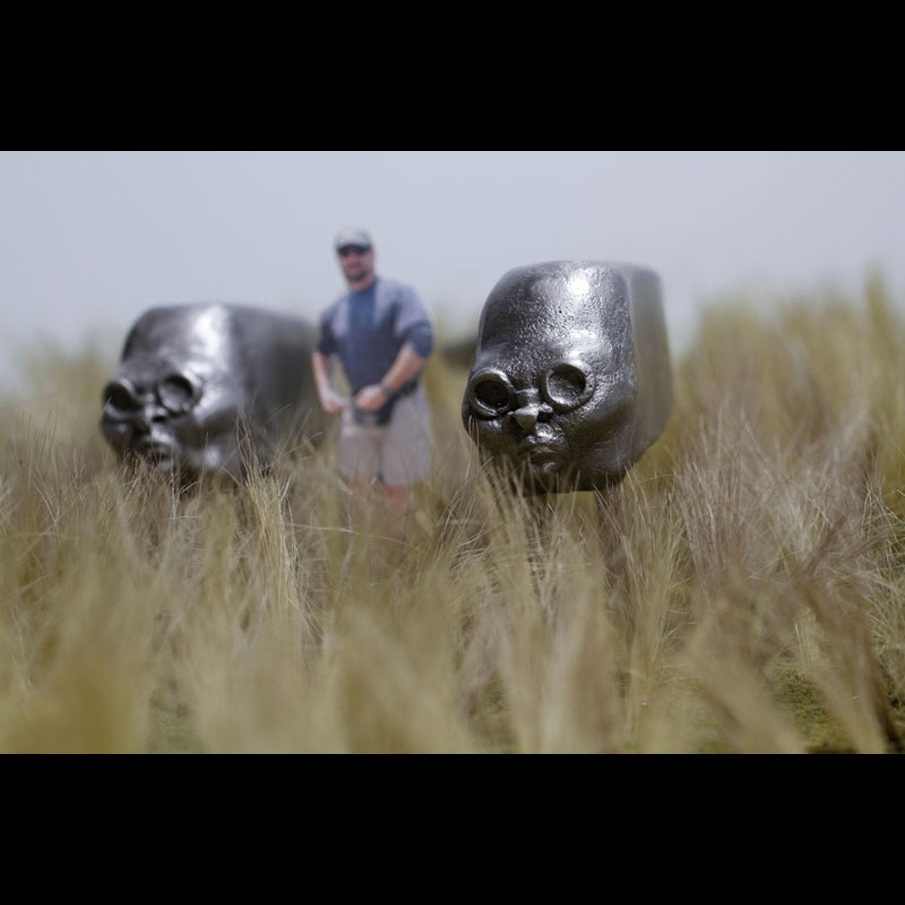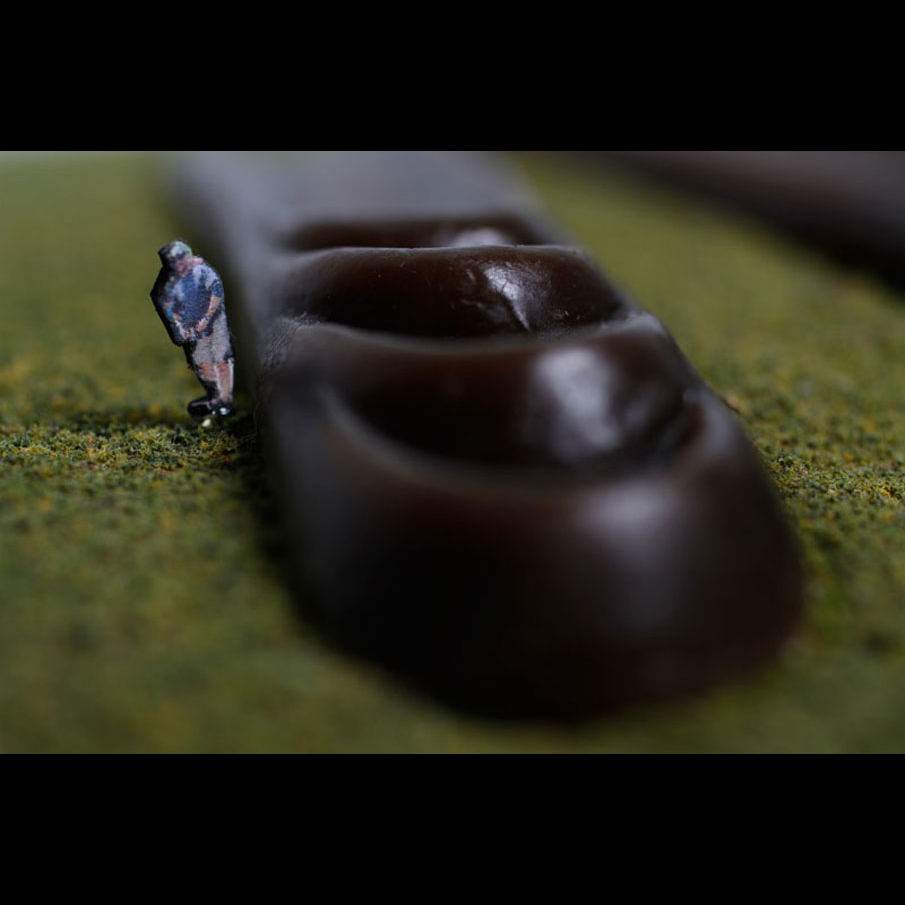Keep Indianapolis Beautiful and the Eli Lilly corporation sought calls for proposals to help enhance the I-70 corridor in the Spring of 2009. As an outsider to Indianapolis, my thoughts about that city were always about movement. Highways and airports were how I first experienced it and the long tradition of racing in the city permeates everything. My proposal for the Holt Road/I-70 interchange was about movement and progress. The sweeping shapes would float above the grasses, their long tapering shapes suggesting speed and motion. The faces imbue a humanity into the forms, rendering them more relatable. Glistening silver in the sun or moonlight, gleaming against the green grasses or white snowfall, these pieces would have stood out and been noticed by passers-by on the highway, Holt Road, and the ramps year round.
Of primary importance to me was creating an idea that suggested what Indianapolis meant to me and what it means to the residents of this neighborhood. My thinking began with a shape much more suggestive of automobiles and was refined and reshaped into what I like to think of as the essence of human progress. Sleek and swiftly moving, determined to reach our dreams and goals; these shapes are this city and its people. For the visitor, they would act as way-finders or arrows, pointing the way to the center of the city.
Although this work went unrealized, it was shown at a conference curated by Stuart Keeler in Baltimore alongside public artwork proposals by Vito Acconci, Janet Echleman, and Mierle Laderman Ukeles.






We the Vehicles
2009
mixed media
1/2" = 1'-0" scale model
On These Shores, Yet to be Cried
Christel DeHaan approached the Herron School of Art and Design in the Fall of 2008 and asked for proposals from the Graduate and Undergraduate art students for her property. When I first visited the DeHaan property that fall I overheard someone make a comment as we moved around the side gardens of the house and the lake came into view. The simple phrase, “it’s breathtaking” started a flood of thoughts and I was absolutely certain at that moment as to exactly what was needed.
I began to think about the “breathtaking” places of my own life and the first place that came immediately to mind was from the oven of the Australian Outback, Kata Tjuta. This geological formation consists of thirty-six domes and is a scared spiritual place to the Aboriginal peoples. Even now, several years after visiting, the photos of this place can still move me like no other.
For the property I proposed an earth-work consisting of 400 yards of topsoil on the hillside across the lake from the house. The intention was to create a new geography unusual to Central Indiana and one that evoked the history of earthen mounds in Native American traditions throughout the region. The shapes were also inspired by the architecture of Gaudi’s La Sagrada Familia in Barcelona, another very moving place experienced in my life. Ultimately, the piece would have hopefully resulted in an environment that both visitors and wildlife could explore and find refuge.






On These Shores, Yet to be Cried
2009
mixed media
1/16" = 1'-0" scale model
Safe Harbor
I spent the summers of my youth in Portage, boating along the coast of Lake Michigan and despite the passage of nearly twenty years I still associate Indiana with water and boats. Additionally, 300 million years ago, a shallow sea known as the Borden Sea covered much of central Indiana. In spite of the current reality of a land-locked Indianapolis, the historical sea and my personal history of water in Indiana, combined with the mission of a hospital, all came together to give meaning to my proposal for a three year artwork loan to Community Hospital North.
My proposal consisted of three essential elements; a boat, a life ring, and “water”. The boat element would be constructed of CNC router cut, 3/4” Baltic Birch plywood mechanically fastened into 6” thick ribs and mounted on steel tube supports. The life ring element will be made up of two parts, “rope” made of painted twisted steel rod and a full-size cold cast bronze life ring. Finally the “water” element would be represented by planted switchgrass, with a mature height of approximately 48”.
The boat and life ring symbolize the hospital and the lifesaving and life-changing services it provides, while the switchgrass symbolizes the water. A gentle breeze will stir the grasses around the ribs of the boat, creating the effect of rippling water. An integral part of this piece is the natural weathering of the boat shapes throughout the three year period. With each passing day the color and shape of the boat would subtly change, providing a brand new piece every day for the one thousand and ninety five days it remained on display. In addition to this, the switchgrass would change and grow with the seasons, further heightening the effect created by the slowly changing wood.




Safe Harbor
2009
mixed media
1" = 1'-0" scale model
photos, except for in progress images, for "We the Vehicles" and "On These Shores, Yet to be Cried" courtesy of Michelle Pemberton